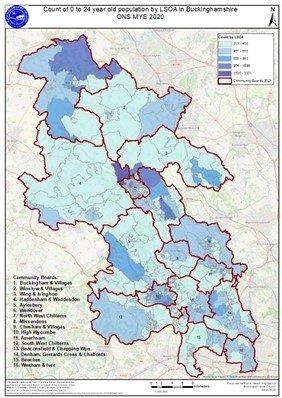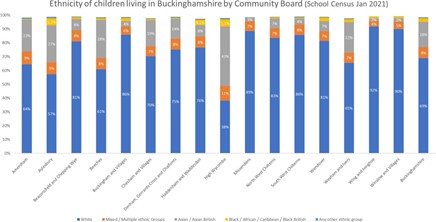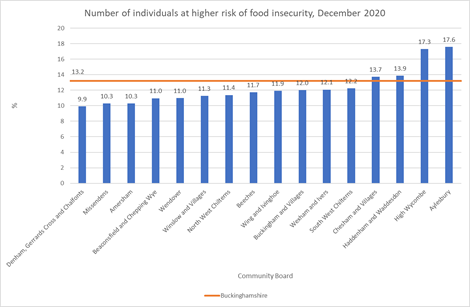Topic Report: Children and young people 2023
4. Local population
In addition to the information included in this report an infographic summary has been published covering the findings.
There are an estimated 161,820 children and young people aged 0 to 24 years living in Buckinghamshire, which makes up 29.1% of the population.
There are higher numbers in areas such as Aylesbury, High Wycombe, Denham, Haddenham, Waddesdon and Beaconsfield all with more than 10,000 children and young people.

Figure 1: Population of 0 to 24 year olds by lower super output area in Buckinghamshire.
There is a 1.3% projected increase between 2020 and 2030 in children aged 8 to 18 years and the highest increases in children and young people are projected in the former district area of Aylesbury Vale.
More than two thirds (69%) of school children living in Buckinghamshire were from a White ethnic group in 2021 and 82% of pupils living in Buckinghamshire report their main language as English. Other more frequently spoken languages are Urdu 3%; Panjabi 2% and Polish 2%.

Figure 2: Ethnicity of children living in Buckinghamshire by Community Board, January 2021.
The proportion of children in relative low-income families in Buckinghamshire has been increasing over the last 5 years with 11.5% of the population under 16 years in relative poverty in 2019/20 compared to 10% in 2015/16.
Some minority ethnic groups have particularly high rates of child poverty. In 2019/20, 46% of minority ethnic children lived in families in poverty after housing costs, compared with 26% of children in White British families in the UK (Child Poverty Action Group's 'child poverty facts and figures').
This data represents the picture pre COVID-19. The COVID-19 pandemic has disrupted lives across the country with families with children some of the hardest hit with job losses and increased cost of living and the impact on children’s education. The COVID-19 pandemic has worsened issues known to underpin child poverty such as financial instability, food insecurity, challenges accessing learning (including the digital divide), access to suitable accommodation and domestic violence and abuse.
Overall, in Buckinghamshire (using 2020 estimates) it was estimated that 13.2% of the population were at risk of food insecurity, which is highest in Aylesbury and High Wycombe.

Figure 3: Number of individuals at higher risk of food insecurity, December 2020
After the first COVID-19 lockdown in 2020 a local Buckinghamshire resident survey showed nearly half (42%) of those who responded with concerns about their finances and being in debt, had children under 18 years in the household.
The concern was higher in regard to affording food and managing debt.